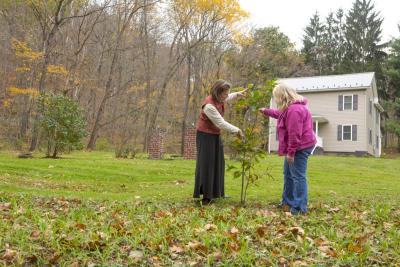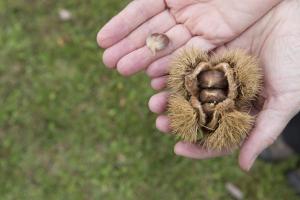For a third year in a row, Citizens Restoring American Chestnuts (CRAC) will be giving away American chestnuts to individuals who are interested in contributing to science while at the same time learning something about the environment. The give-away will be held at the Appalachian Laboratory Open House (301 Braddock Road in Frostburg) on May 2 from 10 a.m. to 2 p.m. The Open House will also have many other hands-on activities to explore science research at the Appalachian Laboratory.
 Citizens Restoring American Chestnuts, a citizen science effort based out of the University of Maryland Center for Environmental Science’s Appalachian Laboratory in Frostburg, directly engages residents of Maryland, Pennsylvania, and West Virginia in chestnut research. Citizen science, also called “public participation in research,” occurs when the public engages in the process of science investigation including asking questions, collecting data, and interpreting results. Such efforts juggle both research and education goals and have been shown to be successful at both.
Citizens Restoring American Chestnuts, a citizen science effort based out of the University of Maryland Center for Environmental Science’s Appalachian Laboratory in Frostburg, directly engages residents of Maryland, Pennsylvania, and West Virginia in chestnut research. Citizen science, also called “public participation in research,” occurs when the public engages in the process of science investigation including asking questions, collecting data, and interpreting results. Such efforts juggle both research and education goals and have been shown to be successful at both.
The research goal of the CRAC project is to determine how different sources of pure American chestnut survive and grow under conditions of the Appalachian Highlands. Beginning in spring 2013 with funds from the Chesapeake Bay Trust, the CRAC project has thus far provided 1,060 seedlings and 1,258 seeds from 4 Maryland and 4 Pennsylvania pure American chestnut sources (i.e., mother trees) to over 150 volunteers.
Volunteers receive instruction on how to plant their seedlings and seeds on their properties and how to report back to Appalachian Laboratory scientists either through a mailed form or through Fieldscope -- an online National Geographic mapping tool that also allows all participants to view data and make comparisons. At the time of planting, volunteers report on the location and habitat conditions of the planting site, such as slope and aspect, soil characteristics, and light environment.
 Twice per year, volunteers then report on survival, tree height in the spring and fall, as well as the date that leaves emerge in the spring and turn color in the fall. CRAC scientists download the data from Fieldscope and analyze them to determine whether survival, growth, and phenology differ among chestnut sources and planting environments.
Twice per year, volunteers then report on survival, tree height in the spring and fall, as well as the date that leaves emerge in the spring and turn color in the fall. CRAC scientists download the data from Fieldscope and analyze them to determine whether survival, growth, and phenology differ among chestnut sources and planting environments.
Data from the first summer and first winter already show differences in survival, growth, and phenology (dates when trees develop new leaves in the spring and change color in the fall) across tree sources and environments. These differences are expected to get stronger as trees overcome the initial challenges of establishing. The long-term goal is to identify American chestnut sources that are adapted (if mother trees are local) or pre-adapted (if mother trees come from elsewhere) to grow well under the varied environment conditions of the Appalachian region.
More information on the project can be found at the Appalachian Laboratory Environmental Science Education website (http://alese.al.umces.edu/crac.html). You can see a map of the seedling locations on a National Geographic (www.fieldscope.org/map/45). For questions or insights, contact project personnel at chestnut@al.umces.edu and talk to CRAC team in person at the Appalachian Laboratory Open House.
